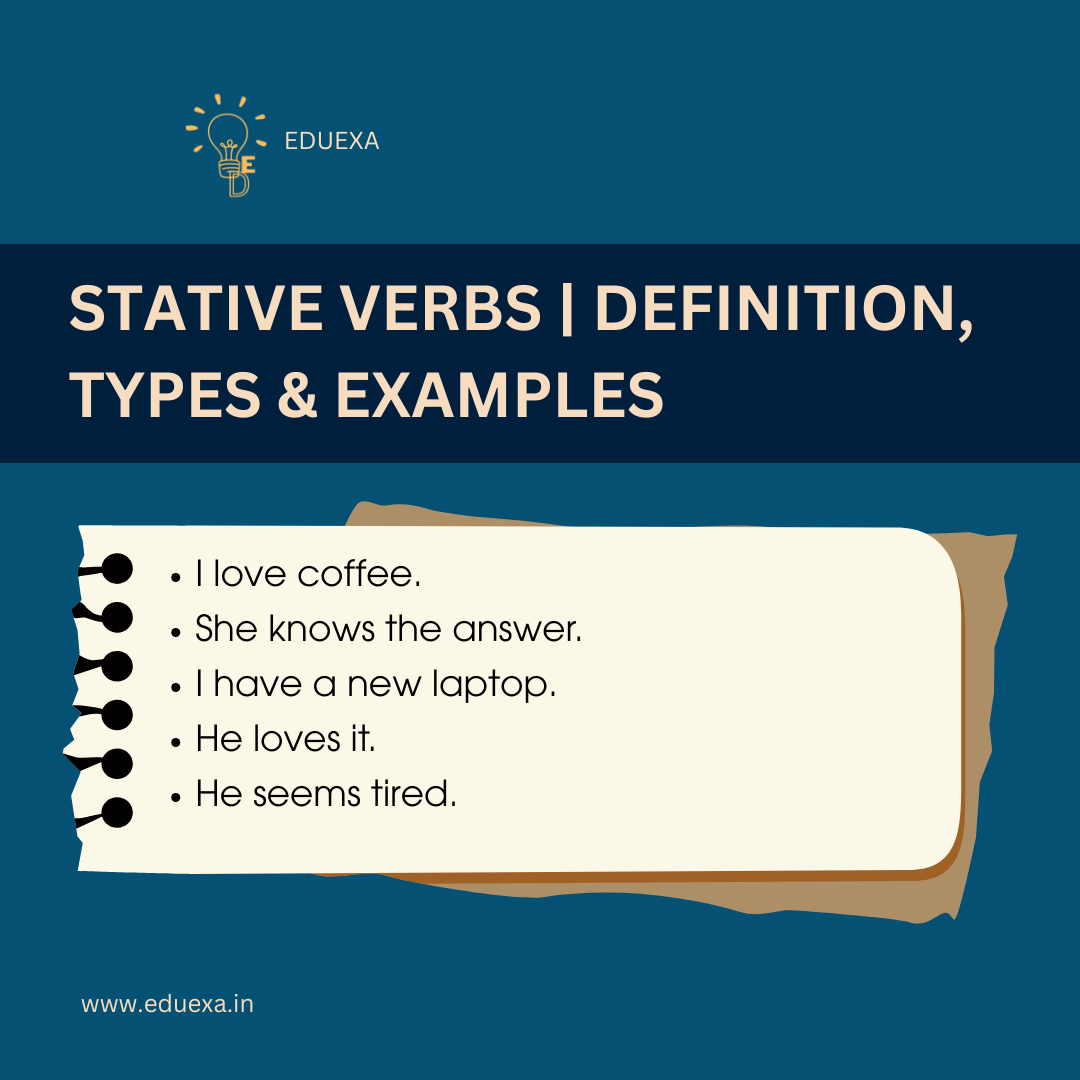Understanding the nuances of English grammar can make a major difference- the one from speaking fluently to speaking correctly. One such nuance lies in stative verbs—a category of verbs that don’t always follow the standard rules of action-based expressions. If you’ve ever wondered why “I am loving this” sounds off to a grammar purist like me, you’re about to find out.
In this blog, we’ll dive deep into the definition of stative verbs, provide an extensive list of common stative verbs, and offer practical examples to help you master this tricky yet essential part of English grammar.
⭐ What Are Stative Verbs?
So let’s understand what exactly Stative verbs (also known as state verbs) are. It basically describes a state of being, emotion, possession, sense, or thought rather than a physical action. Unlike dynamic (action) verbs, stative verbs do not describe activities that can be physically seen or performed.
They are typically not used in the continuous (progressive) tenses because states are not usually temporary or in progress.
Example (Incorrect): I am knowing the meaning.
Correct: I know the meaning.
Stative Verbs vs. Action Verbs
Stative verbs are often contrasted with action or dynamic verbs. While stative verbs indicate a situation or state of being, action verbs describe what the subject of the sentence is doing or has done. Action verbs can refer to both physical and mental actions (e.g, “he ran,” “I’m thinking”).
Some verbs can be either stative or dynamic depending on the meaning of the sentence. For example, the verb “see” can denote an opinion (stative verb), or the physical action of meeting with someone (action verb).
Examples: Stative vs. action verbs
I don’t see any problem with that.
They’ve been seeing each other for a month now.
One way to distinguish stative verbs from action verbs is to look at the verb tense. Stative verbs are never used in the continuous tenses, while action verbs can be used in all verb tenses.
“Check out the upcoming government exam in 2025″
🎯 Stative Verbs vs. Action Verbs (Dynamic Verbs)
| Feature | Stative Verbs | Action Verbs (Dynamic Verbs) |
| Describe | State or condition | Action or process |
| Used in continuous tenses | Rarely | Frequently |
| Examples | know, love, believe | run, write, jump |
| Observable action? | No | Yes |

Stative verbs vs. Linking verbs
Since stative and linking verbs are both used to add more information about the subject of a sentence, you might get confused between these two. You are not alone, a major proportion of the students face this issue. Many verbs can be considered as both linking and stative, such as the sense verbs “taste,” “smell,” and “feel.”
However, it is important to note that not all stative verbs are linking verbs. While stative verbs can be transitive, meaning they take a direct object, linking verbs are not transitive. Linking verbs are always followed by a subject complement (i.e., a noun, pronoun, or adjective that describes the subject).
Examples: Stative verbs vs. linking verbs
I like vanilla ice-cream.
I feel tired.
“Learn about the Ielts Full form and syllabus: Click here“
📚 Types of Stative Verbs with Examples
Let’s break down stative verbs into common categories:
1. Verbs of Emotion
These express feelings and emotions.
- Examples: love, hate, like, prefer, want, need
- ✅ I love coffee.
- ❌ I am loving coffee. (Although sometimes used informally for marketing or emphasis)
2. Verbs of Thinking or Opinion
These represent cognitive states or beliefs.
- Examples: know, believe, understand, remember, think (when referring to opinion), mean, doubt
- ✅ She knows the answer.
- ❌ She is knowing the answer.
3. Verbs of Possession
Used to describe ownership or relationships.
- Examples: have, own, belong, possess, include
- ✅ I have a new laptop.
- ❌ I am having a new laptop. (Unless referring to an experience, e.g., “I’m having lunch.”)
4. Verbs of Senses and Perception
These involve the five senses but are used differently than action verbs.
- Examples: see, hear, taste, smell, feel
- ✅ This soup smells delicious.
- ❌ This soup is smelling delicious.
5. Verbs of Existence or Being
Used to indicate existence or a particular state.
- Examples: be, seem, appear, consist, exist
- ✅ He seems tired.
- ❌ He is seeming tired.
List of stative verbs (Category Wise)
| Thoughts and opinions | Emotions | Senses | Possession | Being and existence | Measurement | Other |
| (Dis)agree | Envy | Appear | Belong | Be | Weigh | Be/are/is |
| Believe | Fear | Feel | Comprise | Seem | Cost | Cost |
| Doubt | Hate | Hear | Consist | Appear | Measure | Depend on |
| Forget | Hope | Look | Contain | Exist | Involve | |
| Know | (dis)like | See | Has/have | Measure | ||
| Recognize | Love | Seem | Include | Owe | ||
| Remember | Need | Sense | Own | Resemble | ||
| Support | Prefer | Smell | Possess | Span | ||
| Suppose | Value | Sound | Lack | Weigh | ||
| Think (opinion) | Want | Taste | Contains | |||
| Understand | Wish | Satisfy | ||||
| Mean | Like | Include | ||||
| Imagine | Love | Matter | ||||
| Suspect | Hate | Deserve | ||||
| Mind | Desire | Equal | ||||
| Prefer | Detest | Concerns | ||||
| Realize | Loathe | Promise | ||||
| Understand | Require | |||||
| Value | Signify |
🔁 When Can Stative Verbs Be Used in Continuous Form?
If you are wondering when can stative verbs be used in continuous form. Let me clear it, while stative verbs are generally not used in continuous tenses, some verbs can be both stative and dynamic depending on their meaning in context.
Example – “Have”
- Stative: I have a pet. (ownership)
- Dynamic: I’m having dinner. (activity)
Example – “Think”
- Stative: I think he’s right. (opinion)
- Dynamic: I’m thinking about quitting my job. (mental process)
Understanding contextual usage is key to mastering stative verbs.
🚫 Common Mistakes with Stative Verbs
Avoid these frequent errors:
- ❌ I am understanding the problem.
✅ I understand the problem. - ❌ She is having two brothers.
✅ She has two brothers. - ❌ They are knowing the rules.
✅ They know the rules. - ❌ We are wanting to leave.
✅ We want to leave.
Grammar Rules for Using Stative Verbs
The major problem that students face with stative verbs is that it tends to show and express the state of being rather than any action. Why is it confusing or difficult? State of being is always explained using continuous tense but Stative Verbs tend to be used in simple tenses. To take you out of this dilemma, understanding the grammar rule of stative verbs is very important. It will not just clear all your doubts but will also guide you to use it correctly enhancing your scores and command over the language.
Here are some of the major rules that can assist you in understanding the use of stative verb in everyday sentences inclusively.
- Express the states, not the action
- Often connected to the five senses, emotions, and relationships
- Can define thoughts, opinions and mental processes
- Can indicate measurements (weight) and possessions (have, own)
- Not used with progressive tenses (continuous tenses – verb with “-ing” form)
- Some stative verbs can be used in continuous tenses when they describe a temporary state or action.
- Stative verbs are mainly used with perfect or simple tenses
- Meaning matters a lot, if used wrong, a stative verb can change the sentence’s meaning.
- Several stative verbs are intransitive, which means in sentences they don’t need a direct object.
- Sometimes used as a linking verb to connect the subject to an identification and description.
These 10 grammar rules of stative verbs are life saving, no… marks saving. It will put all the things and concerns in one perceptive and clear your doubts. Remembering these rules can help you to understand stative verbs in deep and assist you to use them accurately.
💡 Tips to Remember Stative Verbs
- If the verb describes a feeling, possession, thought, or state, it’s likely stative.
- Ask yourself: Can this verb be done physically? If not, avoid using it in continuous tenses.
- Some verbs can be both stative and dynamic—check the context before forming your sentence.
Practice Sentences on Stative Verbs

Instructions:
Read each sentence carefully. Decide whether the use of the verb is correct or incorrect, and if incorrect, correct the sentence.
1. I am knowing the answer.
❌ Incorrect – “know” is a stative verb and should not be used in continuous tense.
✅ Correct: I know the answer.
2. She has a dog.
✅ Correct – “have” (possession) is a stative verb and used properly here.
3. We are wanting more details.
❌ Incorrect – “want” is a stative verb and shouldn’t be in continuous form.
✅ Correct: We want more details.
4. They are tasting the soup.
✅ Correct – When referring to an action (actively tasting), “taste” can be dynamic.
5. This soup tastes great.
✅ Correct – Describes a state (perception), so “tastes” is correctly used in simple present.
6. I think he’s late.
✅ Correct – “Think” used as an opinion is a stative verb.
7. She is thinking about quitting her job.
✅ Correct – “Thinking” in this context refers to a mental action (dynamic usage).
8. He is being rude.
✅ Correct – Although “be” is normally stative, “being” can be used to describe temporary behavior.
9. I’m loving this movie.
❌ Informally acceptable, but grammatically incorrect in formal writing.
✅ Correct (formal): I love this movie.
10. That book belongs to me.
✅ Correct – “Belong” is a stative verb and correctly used in simple present.
Worksheet on Stative Verbs
After exploring almost everything about this verb, it’s time to assess your knowledge. This will make you a master in using this verb in your daily life. Thus, in this section, we have shared exercise of stative verbs. You have to fill in the blanks with the right answer. So, let’s solve this together.
- Aliza ________about her future.
- Ali _______3 sisters.
- It ______like something is burning in the kitchen.
- The girls ____with their new toys.
- Sara_____ like she’s been crying.
- I_____ another tea.
- We_____ a really good vacation.
- Alice and Peter_____ to go to the mall for shopping.
- The shop______ usually very busy in weekdays.
- The baby______ on this crib.
- Worries
- Have
- Smell
- Play
- Look
- Want
- Have
- Need
- Be
- Sleep
🔎 Why Are Stative Verbs Important for English Learners?
- They are essential for fluency and grammatical accuracy.
- Help you avoid awkward or incorrect continuous tense structures.
- Boost your IELTS, TOEFL, and spoken English skills by using precise grammar.
Conclusion
Stative verbs are all about the invisible: feelings, thoughts, ownership, and states of being. They don’t show action, but they shape how we describe ourselves, others, and the world around us.
By understanding when and how to use stative verbs, you can elevate your command of English and avoid common grammatical mistakes. So next time you catch yourself saying, “I’m loving it,” smile at the McDonald’s slogan—but write, “I love it.”
Frequently Asked Questions (FAQs) on Stative Verbs
Q1: What is a stative verb?
A: A stative verb describes a state rather than an action. It refers to emotions, thoughts, relationships, senses, or possession. For example: know, believe, love, own.
Q2: Can stative verbs be used in continuous tense?
A: Generally, no. Stative verbs are not used in continuous tenses because they describe conditions that are static or unchanging. However, some verbs can act as both stative and dynamic, depending on context.
Q3: What are examples of stative verbs?
A: Common stative verbs include:
- Emotion: love, hate, like
- Possession: have, own, belong
- Cognition: know, believe, understand
- Senses: see, hear, smell
- Existence: be, seem, appear
Q4: What is the difference between stative and dynamic verbs?
A:
- Stative verbs describe a condition or state (e.g., know, believe).
- Dynamic verbs show actions or processes (e.g., run, eat, write).
Dynamic verbs are commonly used in continuous forms, while stative verbs are not.
Q5: Is “have” a stative verb?
A: Yes, “have” is stative when it refers to possession (e.g., I have a car). But it can also be dynamic when referring to activities (e.g., I’m having lunch).
Q6: Why is “I am loving it” considered grammatically incorrect?
A: Traditionally, “love” is a stative verb and should not be used in the continuous form. The correct sentence is “I love it.” However, “I’m loving it” is often used informally in marketing or casual speech for emphasis.
Q7: How can I identify a stative verb?
A: Ask yourself:
- Does the verb describe an emotion, possession, or state of mind?
- Can the action be seen or performed physically?
If not, it’s likely a stative verb.
Q8: Are stative verbs important in IELTS or TOEFL exams?
A: Yes. Using correct verb forms like stative vs. dynamic can improve your grammar scores in writing and speaking sections of exams like IELTS, TOEFL, and PTE.
Q9: Can a verb be both stative and dynamic?
A: Absolutely. Some verbs like think, have, and see can function as both stative and dynamic, depending on the meaning.
- I think you’re right. (stative – opinion)
- I’m thinking about my future. (dynamic – mental activity)
Q10: Where can I find more practice on stative verbs?
A: You can find worksheets, quizzes, and grammar lessons on platforms like:
- British Council
- Cambridge English
- Grammarly Blog
- Eduexa resources



